Experimental Investigation on Effects of Water Injection on Rock Frictional Sliding and Its Implications for the Mechanism of Induced Earthquake
Abstract
:1. Introduction
2. Materials and Methods
2.1. Materials
2.2. Methods
2.3. Data Processing
3. Results
3.1. Pressurized Water Injection into the Vicinity of the Fault
3.2. Pressurized Water Injection into the Fault Plane
3.3. The Velocity Stepping Experiments
4. Discussion and Conclusions
4.1. Influence of Rock Permeability
4.2. Influence of Fault Deformation
4.3. Control Effect of the Velocity-Dependence Parameter
4.4. Implications for Induced Earthquakes
Author Contributions
Funding
Institutional Review Board Statement
Informed Consent Statement
Data Availability Statement
Acknowledgments
Conflicts of Interest
References
- Ellsworth, W.L. Injection-Induced Earthquakes. Science 2013, 341, 1225942. [Google Scholar] [CrossRef]
- Grigoli, F.; Cesca, S.; Priolo, E.; Rinaldi, A.P.; Clinton, J.F.; Stabile, T.A.; Dost, B.; Fernandez, M.G.; Wiemer, S.; Dahm, T. Current challenges in monitoring, discrimination, and management of induced seismicity related to underground industrial activities: A European perspective. Rev. Geophys. 2017, 55, 310–340. [Google Scholar] [CrossRef]
- Fisher, Q.; Casey, M.; Harris, S.; Knipe, R. Fluid-flow properties of faults in sandstone: The importance of temperature history. Geology 2003, 31, 965–968. [Google Scholar] [CrossRef]
- Yang, H.; Liu, Y.; Wei, M.; Zhuang, J.; Zhou, S. Induced earthquakes in the development of unconventional energy resources. Sci. China Earth Sci. 2017, 60, 1632–1644. [Google Scholar] [CrossRef]
- Langenbruch, C.; Zoback, M.D. How will induced seismicity in Oklahoma respond to decreased saltwater injection rates? Sci. Adv. 2016, 2, e1601542. [Google Scholar] [CrossRef]
- Weingarten, M.; Ge, S.; Godt, J.W.; Bekins, B.A.; Rubinstein, J.L. High-rate injection is associated with the increase in U.S. mid-continent seismicity. Science 2015, 348, 1336–1340. [Google Scholar] [CrossRef]
- Keranen, K.M.; Weingarten, M.; Abers, G.A.; Bekins, B.A.; Ge, S. Sharp increase in central Oklahoma seismicity since 2008 induced by massive wastewater injection. Science 2014, 345, 448–451. [Google Scholar] [CrossRef]
- Kim, W.-Y. Induced seismicity associated with fluid injection into a deep well in Youngstown, Ohio. J. Geophys. Res. Solid Earth 2013, 118, 3506–3518. [Google Scholar] [CrossRef]
- Atkinson, G.M.; Eaton, D.W.; Ghofrani, H.; Walker, D.; Cheadle, B.; Schultz, R.; Shcherbakov, R.; Tiampo, K.; Gu, J.; Harrington, R.M.; et al. Hydraulic Fracturing and Seismicity in the Western Canada Sedimentary Basin. Seismol. Res. Lett. 2016, 87, 631–647. [Google Scholar] [CrossRef]
- Bao, X.; Eaton, D.W. Fault activation by hydraulic fracturing in western Canada. Science 2016, 354, 1406–1409. [Google Scholar] [CrossRef]
- Lei, X.; Ma, S.; Chen, W.; Pang, C.; Zeng, J.; Jiang, B. A detailed view of the injection-induced seismicity in a natural gas reservoir in Zigong, southwestern Sichuan Basin, China. J. Geophys. Res. Solid Earth 2013, 118, 4296–4311. [Google Scholar] [CrossRef]
- Lei, X.; Su, J.; Wang, Z. Growing seismicity in the Sichuan Basin and its association with industrial activities. Sci. China Earth Sci. 2020, 63, 1633–1660. [Google Scholar] [CrossRef]
- Lei, X.; Wang, Z.; Su, J. Possible link between long-term and short-term water injections and earthquakes in salt mine and shale gas site in Changning, south Sichuan Basin, China. Earth Planet. Phys. 2019, 3, 510–525. [Google Scholar] [CrossRef]
- Lei, X.; Wang, Z.; Su, J. The December 2018 ML 5.7 and January 2019 ML 5.3 Earthquakes in South Sichuan Basin Induced by Shale Gas Hydraulic Fracturing. Seismol. Res. Lett. 2019, 90, 1099–1110. [Google Scholar] [CrossRef]
- Yang, H.; Zhou, P.; Fang, N.; Zhu, G.; Xu, W.; Su, J.; Meng, F.; Chu, R. A Shallow Shock: The 25 February 2019 ML 4.9 Earthquake in the Weiyuan Shale Gas Field in Sichuan, China. Seismol. Res. Lett. 2020, 91, 3182–3194. [Google Scholar] [CrossRef]
- Lei, X.; Huang, D.; Su, J.; Jiang, G.; Wang, X.; Wang, H.; Guo, X.; Fu, H. Fault reactivation and earthquakes with magnitudes of up to Mw4.7 induced by shale-gas hydraulic fracturing in Sichuan Basin, China. Sci. Rep. 2017, 7, 7971. [Google Scholar] [CrossRef]
- Ellsworth, W.L.; Giardini, D.; Townend, J.; Ge, S.; Shimamoto, T. Triggering of the Pohang, Korea, Earthquake (Mw 5.5) by Enhanced Geothermal System Stimulation. Seismol. Res. Lett. 2019, 90, 1844–1858. [Google Scholar] [CrossRef]
- Deichmann, N.; Giardini, D. Earthquakes Induced by the Stimulation of an Enhanced Geothermal System below Basel (Switzerland). Seismol. Res. Lett. 2009, 80, 784–798. [Google Scholar] [CrossRef]
- Kozlowska, M.; Brudzinski, M.R.; Friberg, P.; Skoumal, R.J.; Baxter, N.D.; Currie, B.S. Maturity of nearby faults influences seismic hazard from hydraulic fracturing. Proc. Natl. Acad. Sci. USA 2018, 115, E1720–E1729. [Google Scholar] [CrossRef]
- Horton, S. Disposal of Hydrofracking Waste Fluid by Injection into Subsurface Aquifers Triggers Earthquake Swarm in Central Arkansas with Potential for Damaging Earthquake. Seismol. Res. Lett. 2012, 83, 250–260. [Google Scholar] [CrossRef]
- Shah, A.K.; Keller, G.R. Geologic influence on induced seismicity: Constraints from potential field data in Oklahoma. Geophys. Res. Lett. 2017, 44, 152–161. [Google Scholar] [CrossRef]
- Lockner, D.; Byerlee, J.D. Hydrofracture in Weber Sandstone at high confining pressure and differential stress. J. Geophys. Res. 1977, 82, 2018–2026. [Google Scholar] [CrossRef]
- Byerlee, J.D.; Lockner, D.A. Acoustic emission during fluid injection in rock. In Proceedings of the First Conference on Acoustic Emission/Microseismic Activity in Geological Structures and Materials, State College, PA, USA, 1 January 1977; pp. 87–98. [Google Scholar]
- Masuda, K.; Nishizawa, O.; Kusunose, K.; Satoh, T.; Takahashi, M.; Kranz, R.L. Positive feedback fracture process induced by nonuniform high-pressure water flow in dilatant granite. J. Geophys. Res. 1990, 95, 21583–21592. [Google Scholar] [CrossRef]
- Li, X.; Lei, X.; Li, Q. Injection-induced fracturing process in a tight sandstone under different saturation conditions. Environ. Earth Sci. 2016, 75, 1466. [Google Scholar] [CrossRef]
- Lei, X.; Tamagawa, T.; Tezuka, K.; Takahashi, M. Role of drainage conditions in deformation and fracture of porous rocks under triaxial compression in the laboratory. Geophys. Res. Lett. 2011, 38, L24310. [Google Scholar] [CrossRef]
- Scuderi, M.M.; Collettini, C. Fluid Injection and the Mechanics of Frictional Stability of Shale-Bearing Faults. J. Geophys. Res. Solid Earth 2018, 123, 8364–8384. [Google Scholar] [CrossRef]
- Scuderi, M.M.; Collettini, C.; Marone, C. Frictional stability and earthquake triggering during fluid pressure stimulation of an experimental fault. Earth Planet. Sci. Lett. 2017, 477, 84–96. [Google Scholar] [CrossRef]
- Jeong, S.; Stump, B.W.; DeShon, H.R. Spectral Characteristics of Ground Motion from Induced Earthquakes in the Fort Worth Basin, Texas, Using the Generalized Inversion Technique. Bull. Seismol. Soc. Am. 2020, 110, 2058–2076. [Google Scholar] [CrossRef]
- Kolawole, F.; Johnston, C.S.; Morgan, C.B.; Chang, J.C.; Marfurt, K.J.; Lockner, D.A.; Reches, Z.; Carpenter, B.M. The susceptibility of Oklahoma’s basement to seismic reactivation. Nat. Geosci. 2019, 12, 839–844. [Google Scholar] [CrossRef]
- Kranz, R.L.; Saltzman, J.; Blacic, J.D. Hydraulic diffusivity measurements on laboratory rock samples using an oscillating pore pressure method. Int. J. Rock Mech. Min. Sci. Geomech. Abstr. 1990, 27, 345–352. [Google Scholar] [CrossRef]
- He, C.; Yao, W.; Wang, Z.; Zhou, Y. Strength and stability of frictional sliding of gabbro gouge at elevated temperatures. Tectonophysics 2006, 427, 217–229. [Google Scholar] [CrossRef]
- Tiab, D.; Donaldson, E.C. Introduction to Petroleum Geology. In Petrophysics, 4th ed.; Tiab, D., Donaldson, E.C., Eds.; Gulf Professional Publishing: Waltham, MA, USA, 2016; pp. 23–66. [Google Scholar]
- Eyre, T.S.; Eaton, D.W.; Garagash, D.I.; Zecevic, M.; Venieri, M.; Weir, R.; Lawton, D.C. The role of aseismic slip in hydraulic fracturing–induced seismicity. Sci. Adv. 2019, 5, eaav7172. [Google Scholar] [CrossRef] [PubMed]
- Dieterich, J. Modeling of rock friction: 1. Experimental Results and constitutive equations. J. Geophys. Res. 1979, 84, 2161–2168. [Google Scholar] [CrossRef]
- Marone, C.; Marone, C. Laboratory-derived friction laws and their application to seismic faulting. Annu. Rev. Earth Planet. Sci. 1998, 26, 643–696. [Google Scholar] [CrossRef]
- Ruina, A. Slip instability and state variable friction laws. J. Geophys. Res. Solid Earth 1983, 88, 10359–10370. [Google Scholar] [CrossRef]
- Chen, J.; Verberne, B.A.; Spiers, C.J. Effects of healing on the seismogenic potential of carbonate fault rocks: Experiments on samples from the Longmenshan Fault, Sichuan, China. J. Geophys. Res. Solid Earth 2015, 120, 5479–5506. [Google Scholar] [CrossRef]
- Samuelson, J.; Elsworth, D.; Marone, C. Shear-induced dilatancy of fluid-saturated faults: Experiment and theory. J. Geophys. Res. 2009, 114, B12404. [Google Scholar] [CrossRef]
- Blanpied, M.L.; Lockner, D.A.; Byerlee, J.D. An earthquake mechanism based on rapid sealing of faults. Nature 1992, 358, 574–576. [Google Scholar] [CrossRef]
- Medici, G.; West, L.J. Reply to Discussion on ‘Review of groundwater flow and contaminant transport modelling approaches for the Sherwood Sandstone Aquifer, UK; insights from analogous successions worldwide’ by Medici and West (QJEGH, 55, qjegh2021-176). Q. J. Eng. Geol. Hydrogeol. 2023, 56. [Google Scholar] [CrossRef]
- Medici, G.; West, L.J.; Mountney, N.P.; Welch, M. Permeability of rock discontinuities and faults in the Triassic Sherwood Sandstone Group (UK): Insights for management of fluvio-aeolian aquifers worldwide. Hydrogeol. J. 2019, 27, 2835–2855. [Google Scholar] [CrossRef]
- Logan, J.M.; Teufel, L.W. The effect of normal stress on the real area of contact during frictional sliding in rocks. Pure Appl. Geophys. 1986, 124, 471–486. [Google Scholar] [CrossRef]
- Brown, S.; Scholz, C. Closure of Rock Joints. J. Geophys. Res. 1986, 91, 4939–4948. [Google Scholar] [CrossRef]
- Dieterich, J.H.; Richards-Dinger, K.B.; Kroll, K.A. Modeling Injection-Induced Seismicity with the Physics-Based Earthquake Simulator RSQSim. Seismol. Res. Lett. 2015, 86, 1102–1109. [Google Scholar] [CrossRef]
- McGarr, A. Maximum magnitude earthquakes induced by fluid injection. J. Geophys. Res. Solid Earth 2014, 119, 1008–1019. [Google Scholar] [CrossRef]
- Chen, J.; Verberne, B.A.; Spiers, C.J. Interseismic re-strengthening and stabilization of carbonate faults by “non-Dieterich” healing under hydrothermal conditions. Earth Planet. Sci. Lett. 2015, 423, 1–12. [Google Scholar] [CrossRef]
- Verberne, B.A.; de Bresser, J.H.P.; Niemeijer, A.R.; Spiers, C.J.; de Winter, D.A.M.; Plümper, O. Nanocrystalline slip zones in calcite fault gouge show intense crystallographic preferred orientation: Crystal plasticity at sub-seismic slip rates at 18–150 °C. Geology 2013, 41, 863–866. [Google Scholar] [CrossRef]
- Huang, Y.; Ma, S.; Miao, A.; Yang, M. Effect of normal stress perturbation on frictional instability: An experimental study. Chin. J. Geophys. 2016, 59, 931–940. (In Chinese) [Google Scholar] [CrossRef]
- Huang, Y.; Lei, X.; Ma, S. Numerical study of the role of localized stress perturbations on fault slip: Insights for injection-induced fault reactivation. Tectonophysics 2021, 819, 229105. [Google Scholar] [CrossRef]
- Norbeck, J.H.; Horne, R.N. Maximum magnitude of injection-induced earthquakes: A criterion to assess the influence of pressure migration along faults. Tectonophysics 2018, 733, 108–118. [Google Scholar] [CrossRef]
- Lockner, D.A.; Beeler, N.M. Premonitory slip and tidal triggering of earthquakes. J. Geophys. Res. Solid Earth 1999, 104, 20133–20151. [Google Scholar] [CrossRef]
- Gischig, V.S. Rupture propagation behavior and the largest possible earthquake induced by fluid injection into deep reservoirs. Geophys. Res. Lett. 2015, 42, 7420–7428. [Google Scholar] [CrossRef]
- Blanpied, M.; Lockner, D.; Byerlee, J. Frictional slip of granite at hydrothermal conditions. J. Geophys. Res. 1995, 1001, 13045–13064. [Google Scholar] [CrossRef]
- Sawai, M.; Niemeijer, A.R.; Plümper, O.; Hirose, T.; Spiers, C.J. Nucleation of frictional instability caused by fluid pressurization in subducted blueschist. Geophys. Res. Lett. 2016, 43, 2543–2551. [Google Scholar] [CrossRef]
- Atkinson, G.M.; Eaton, D.W.; Igonin, N. Developments in understanding seismicity triggered by hydraulic fracturing. Nat. Rev. Earth Environ. 2020, 1, 264–277. [Google Scholar] [CrossRef]
- Tan, Y.; Hu, J.; Zhang, H.; Chen, Y.; Qian, J.; Wang, Q.; Zha, H.; Tang, P.; Nie, Z. Hydraulic Fracturing Induced Seismicity in the Southern Sichuan Basin Due to Fluid Diffusion Inferred From Seismic and Injection Data Analysis. Geophys. Res. Lett. 2020, 47, e2019GL084885. [Google Scholar] [CrossRef]
- Goebel, T.H.W.; Hosseini, S.M.; Cappa, F.; Hauksson, E.; Ampuero, J.P.; Aminzadeh, F.; Saleeby, J.B. Wastewater disposal and earthquake swarm activity at the southern end of the Central Valley, California. Geophys. Res. Lett. 2016, 43, 1092–1099. [Google Scholar] [CrossRef]
- Keranen, K.M.; Savage, H.M.; Abers, G.A.; Cochran, E.S. Potentially induced earthquakes in Oklahoma, USA: Links between wastewater injection and the 2011 Mw 5.7 earthquake sequence. Geology 2013, 41, 699–702. [Google Scholar] [CrossRef]
- Boettcher, M.S.; Marone, C. Effects of normal stress variation on the strength and stability of creeping faults. J. Geophys. Res. 2004, 109, B03406. [Google Scholar] [CrossRef]
- Yeck, W.L.; Hayes, G.P.; McNamara, D.E.; Rubinstein, J.L.; Barnhart, W.D.; Earle, P.S.; Benz, H.M. Oklahoma experiences largest earthquake during ongoing regional wastewater injection hazard mitigation efforts. Geophys. Res. Lett. 2017, 44, 711–717. [Google Scholar] [CrossRef]
- Yeck, W.L.; Weingarten, M.; Benz, H.M.; McNamara, D.E.; Bergman, E.A.; Herrmann, R.B.; Rubinstein, J.L.; Earle, P.S. Far-field pressurization likely caused one of the largest injection induced earthquakes by reactivating a large preexisting basement fault structure. Geophys. Res. Lett. 2016, 43, 10198–10207. [Google Scholar] [CrossRef]
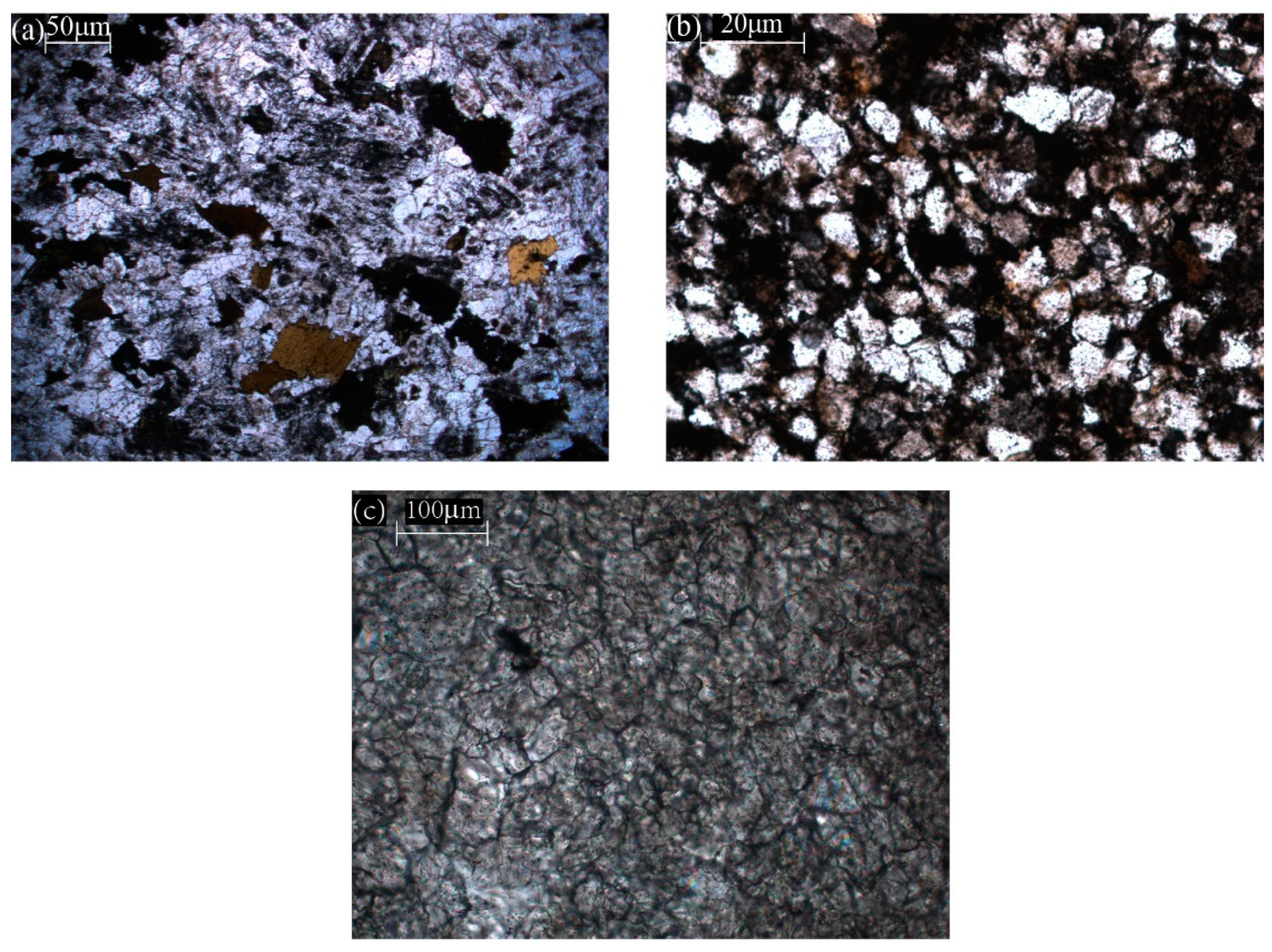

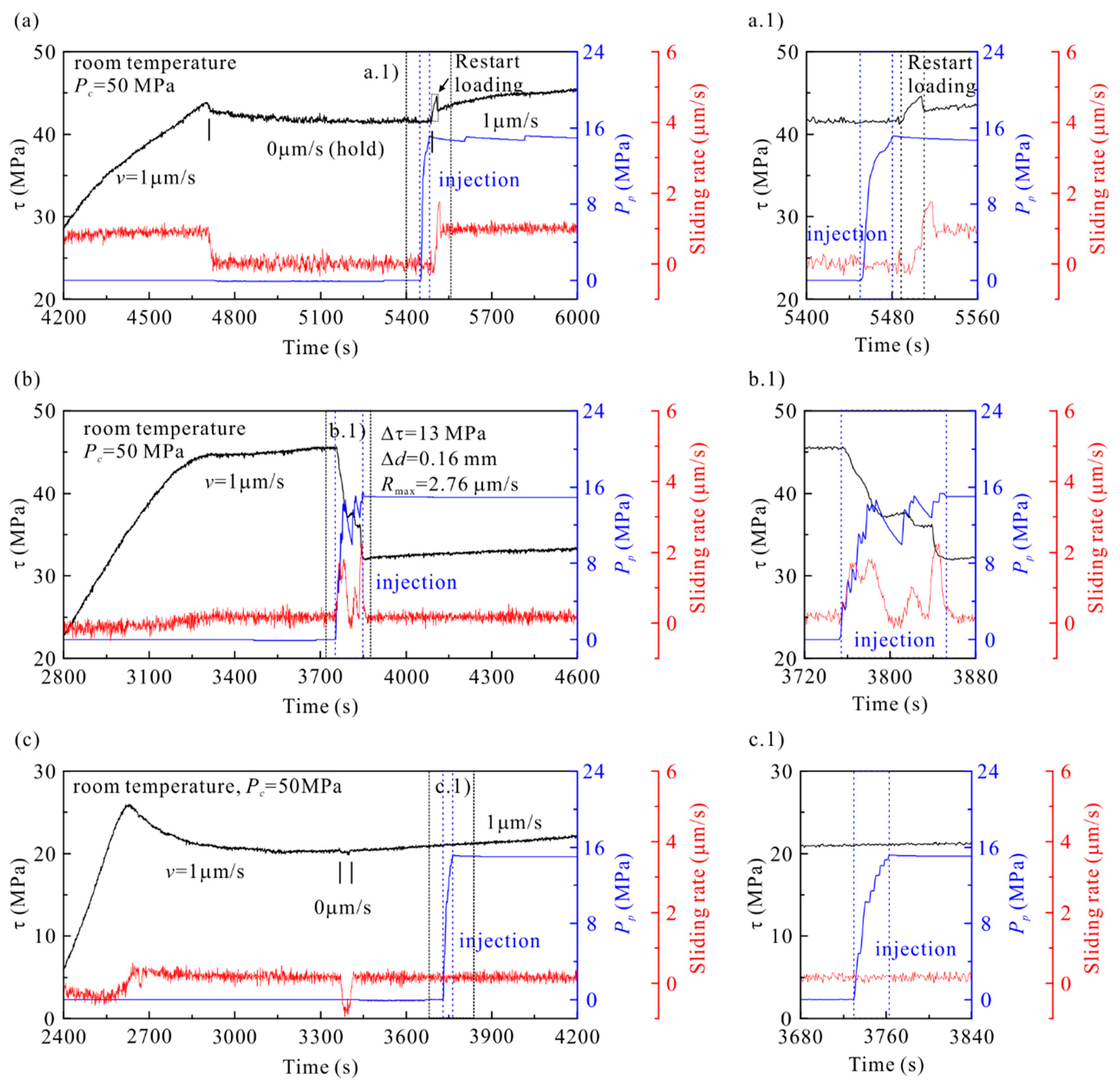

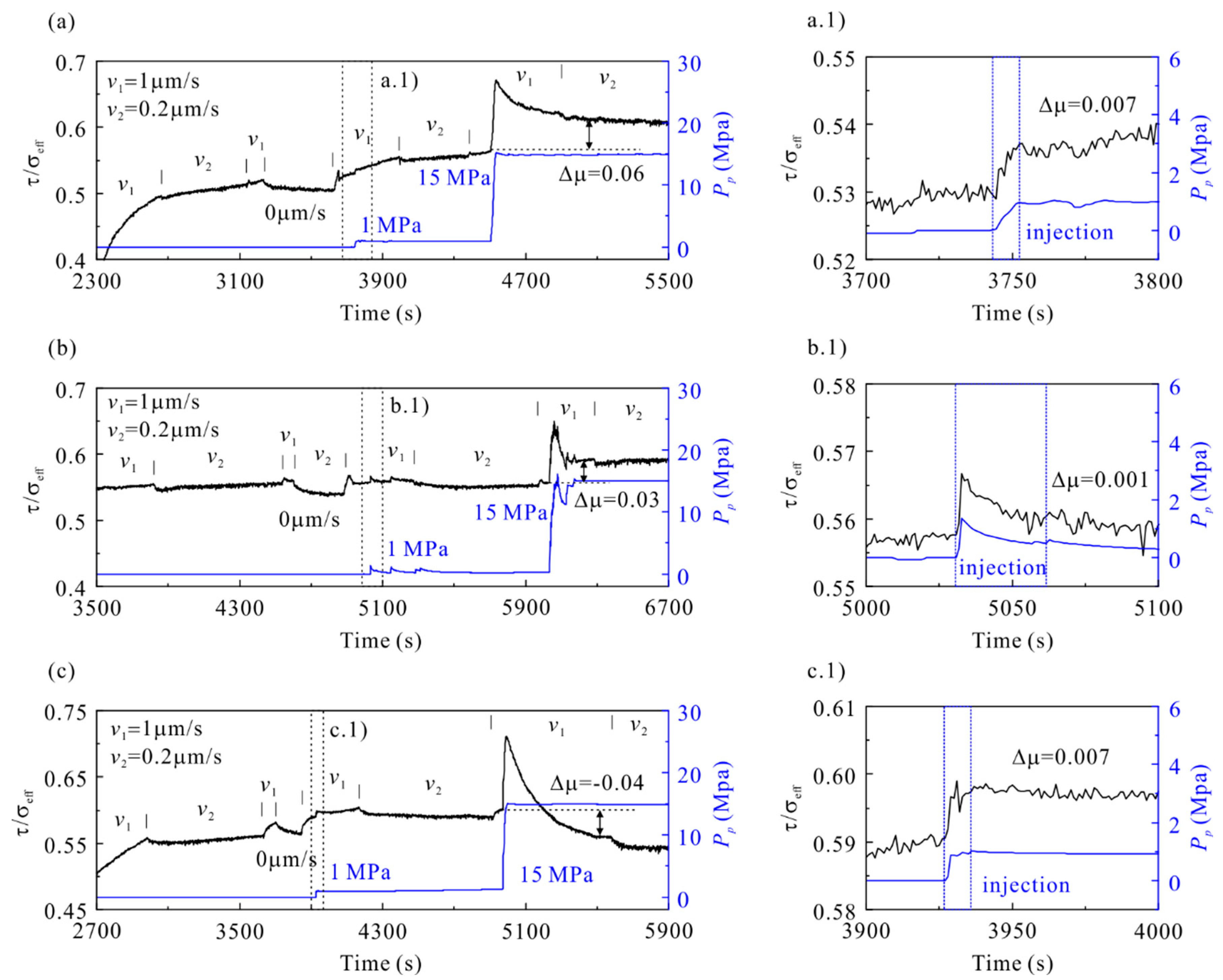
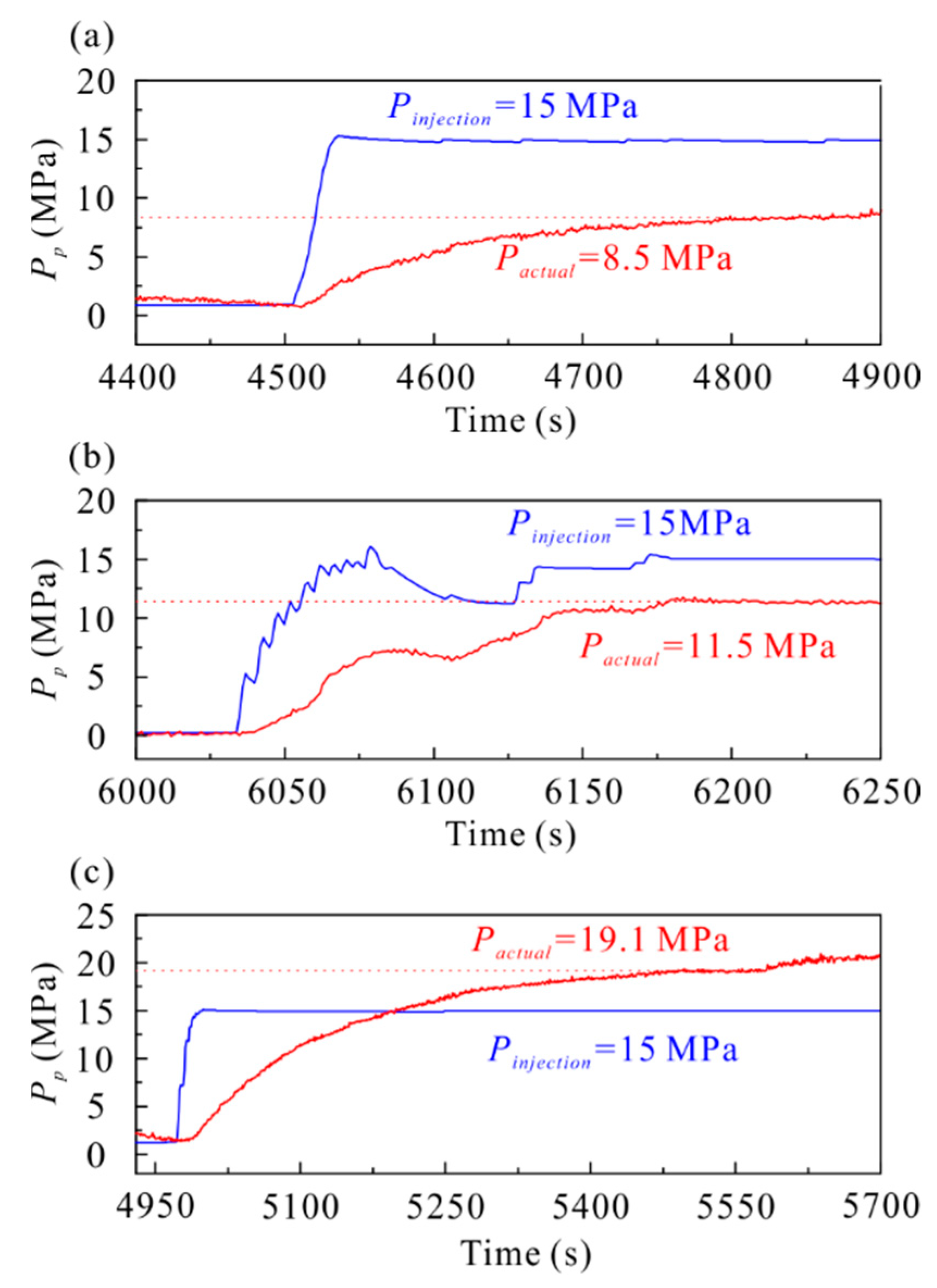
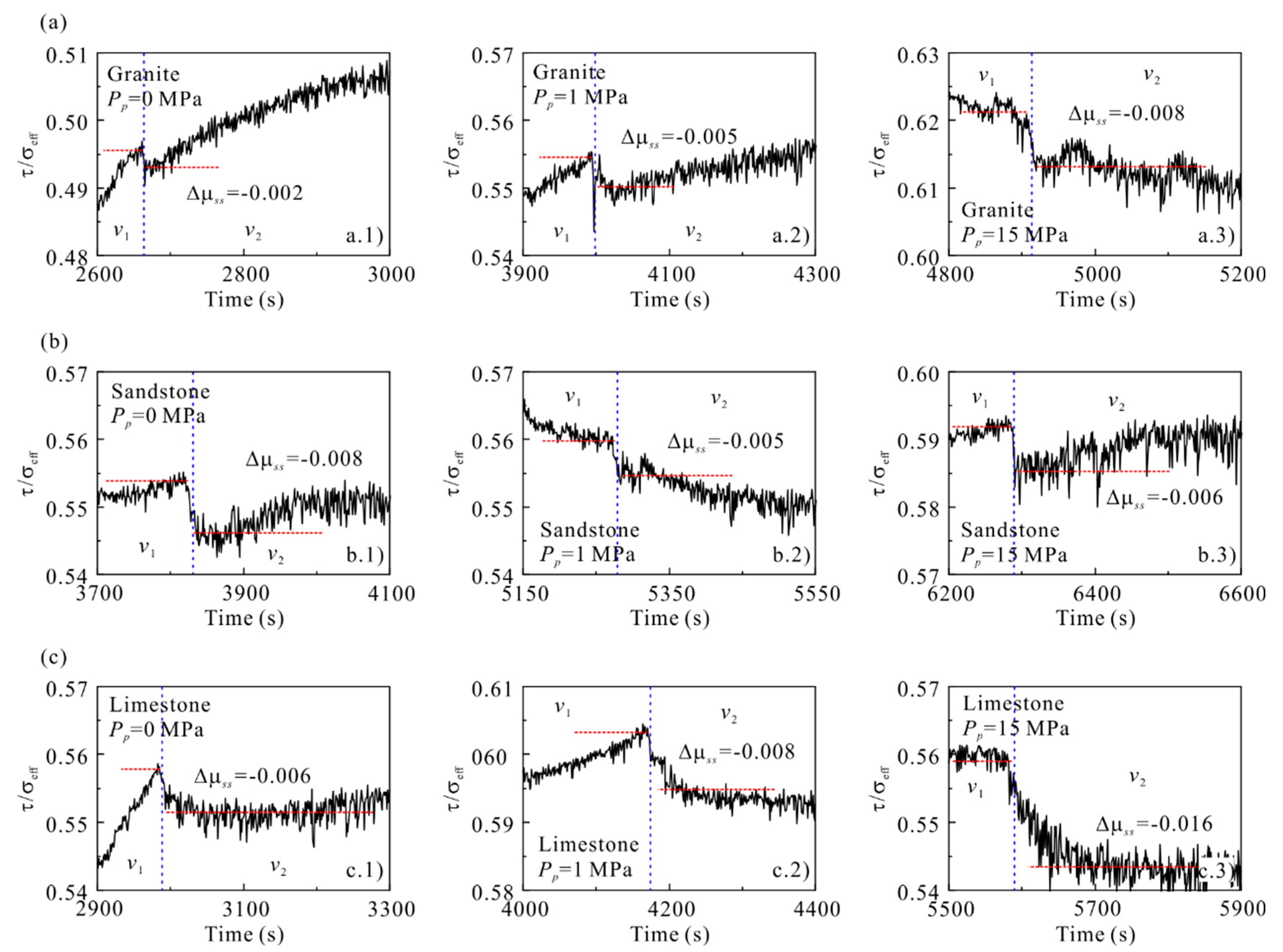
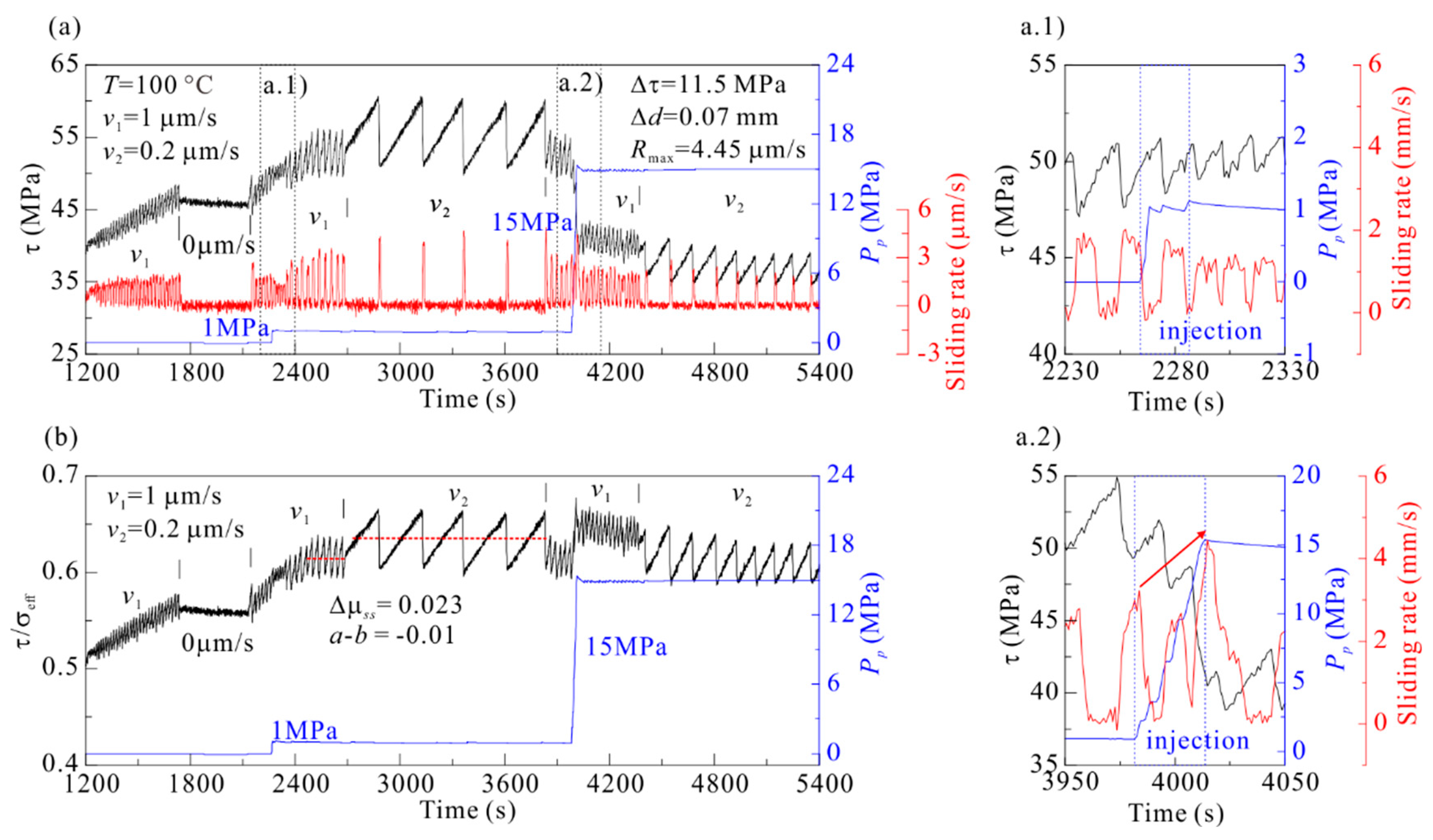
| Samples | Mineral Component | Permeability (m2) |
|---|---|---|
| Granite | Plagioclase, potassium feldspar, quartz, amphibole, and magnetite | 2.25 × 10−19 |
| Sandstone | Quartz, feldspar, biotite, and clay | 2.66 × 10−17 |
| Limestone | Calcite and clay | 3.88 × 10−22 |
| Experiment | Sample | Borehole Type | T | Pc | Pp | v | Slip Behavior |
|---|---|---|---|---|---|---|---|
| Run-1 | Granite | blind | rT | 50 | 15 | 1 | Stable slip |
| Run-2 | Sandstone | blind | rT | 50 | 15 | 1 | Stable slip |
| Run-3 | Limestone | blind | rT | 50 | 15 | 1 | Stable slip |
| Run-4 | Granite | open | rT | 50 | 1&15 | 1&0.2 | Stable slip |
| Run-5 | Sandstone | open | rT | 50 | 1&15 | 1&0.2 | Stable slip |
| Run-6 | Limestone | open | rT | 50 | 1&15 | 1&0.2 | Stable slip |
| Run-7 | Limestone | open | 100 °C | 50 | 1&15 | 1&0.2 | Stick-slip |
| Fault | Dry | Injection of 1 MPa Pressurized Water | Injection of 15 MPa Pressurized Water | |||||||
|---|---|---|---|---|---|---|---|---|---|---|
| μa | a − b | μa | a − b | μa | a − b | Δτ | Dis | tslide | Pactral | |
| Granite | 0.52~0.53 | 0.0009 | 0.54~0.56 | 0.022 | 0.61~0.62 | 0.034 | 6.9 | 0.28 | 290 | 8.5 |
| Sandstone | 0.56 | 0.034 | 0.56 | 0.022 | 0.59 | 0.026 | 10.4 | 0.19 | 145 | 11.5 |
| Limestone | 0.58~0.59 | 0.026 | 0.60 | 0.034 | 0.56 | 0.069 | 18 | 0.57 | 490 | 19.1 |
Disclaimer/Publisher’s Note: The statements, opinions and data contained in all publications are solely those of the individual author(s) and contributor(s) and not of MDPI and/or the editor(s). MDPI and/or the editor(s) disclaim responsibility for any injury to people or property resulting from any ideas, methods, instructions or products referred to in the content. |
© 2023 by the authors. Licensee MDPI, Basel, Switzerland. This article is an open access article distributed under the terms and conditions of the Creative Commons Attribution (CC BY) license (https://creativecommons.org/licenses/by/4.0/).
Share and Cite
Huang, Y.; Zhang, L.; Ma, S.; Li, X. Experimental Investigation on Effects of Water Injection on Rock Frictional Sliding and Its Implications for the Mechanism of Induced Earthquake. Appl. Sci. 2023, 13, 11466. https://doi.org/10.3390/app132011466
Huang Y, Zhang L, Ma S, Li X. Experimental Investigation on Effects of Water Injection on Rock Frictional Sliding and Its Implications for the Mechanism of Induced Earthquake. Applied Sciences. 2023; 13(20):11466. https://doi.org/10.3390/app132011466
Chicago/Turabian StyleHuang, Yuanmin, Lei Zhang, Shengli Ma, and Xiaohui Li. 2023. "Experimental Investigation on Effects of Water Injection on Rock Frictional Sliding and Its Implications for the Mechanism of Induced Earthquake" Applied Sciences 13, no. 20: 11466. https://doi.org/10.3390/app132011466
APA StyleHuang, Y., Zhang, L., Ma, S., & Li, X. (2023). Experimental Investigation on Effects of Water Injection on Rock Frictional Sliding and Its Implications for the Mechanism of Induced Earthquake. Applied Sciences, 13(20), 11466. https://doi.org/10.3390/app132011466





